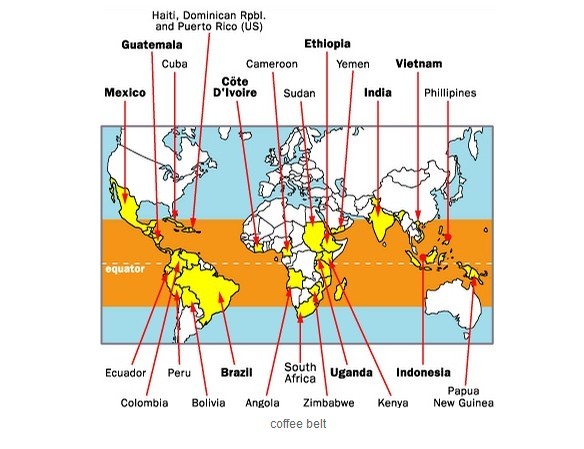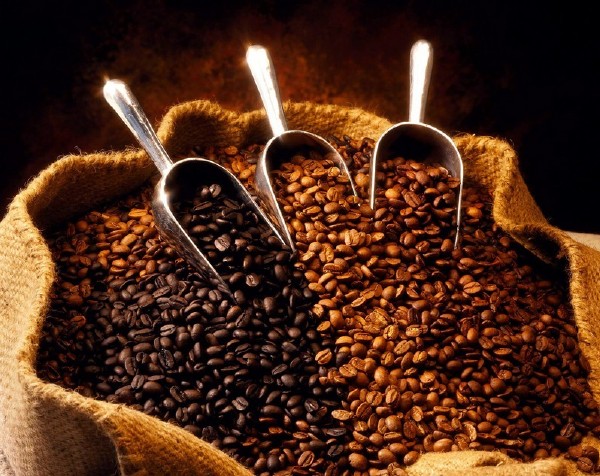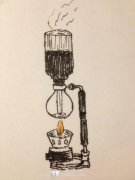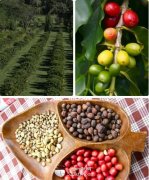Where do coffee beans come from? The production zone of boutique coffee beans

Coffee trees need high altitudes, tropical climates, and fertile soil to grow the best coffee beans. Such climatic conditions on Earth occur around the equator, roughly between 25 ° N and 30 ° S.
In addition to geographical location, there are many other factors that affect coffee quality: planting methods, soil fertility, weather, especially rainfall and light, and the exact latitude. All these factors combined with the way coffee beans are processed create the diversity of coffee produced in different countries and regions of the world. The combination of factors is very complex, and often there will be differences in quality and flavor in the same plantation.
Coffee is grown in more than 50 countries and regions around the world, and the following are some of them:
North America and the Caribbean
Hawaii
Although coffee farms are scattered throughout the Hawaiian Islands, only KONA Island (Hawaii's largest island) has a reputation for coffee and is in great demand. The active volcanic slopes of MAUNA LOA on the island provide the best natural environment for coffee growing. Coffee seedlings are planted in newly formed black volcanic mud, as if they were growing on rock. Tropical clouds naturally form a canopy of vegetation in the afternoon, blocking out the scorching sun. Intermittent showers on the island bring just the right amount of rain. KONA coffee is carefully crafted to be a medium full-bodied coffee with rich taste and aroma.
Mexico
Although Mexican coffee is not grown on a large scale, it is made up of small plantations of more than 100,000 farmers, making it one of the largest coffee growers in the world. The main plantations are concentrated in the southern provinces formerly known as VERACRUZ,OAXACA and CHIAPAS. A cup of Mexican coffee is usually very rich in aroma, and there is often a hint of distinct sharpness behind the heavy taste. This fine quality coffee bean is usually used for deep roasting and blending. Mexican coffee labeled ALTURA stands for highlands.
Puerto Rico
Coffee was brought to Puerto Rico by MARTINIQUE in 1736 and became the world's sixth largest coffee exporter in the late 19th century. Good times don't last long, and hurricanes and other competitors are forcing Puerto Rico to look for other economic growth points. Today, the coffee industry is starting to recover. Arabica coffee is cultivated carefully to produce the highest quality coffee beans. GRAND LARES in the south-central Caribbean Islands and YAUCO SELECTO Island in the south-west are the most important and best quality producing areas. It is known for producing coffee beans with balanced acidity and fruity taste.

Central America
Guatemala
Guatemala has been working to establish a coffee industry of higher standards and consistent quality. Guatemala is less famous for its coffee than its neighbors in Central and South America. A lot of people like the unique texture of its rich flavor. ANTIGUA,COBAN and HEUHUETANGE are the three main coffee producing regions, each with intense rugged mountains and fertile volcanic soils. Microclimate conditions determine coffee quality and flavor at altitudes above 4500 feet. A cup of Guatemala coffee, medium to highly full-bodied, slightly spicy and chocolatey in depth.
Costa Rica
Central American coffee is famous and of high quality. Costa Rica produces only water-washed ARABICA beans. The beans are moderately full in taste and have a strong acidity. Baristas often describe Costa Rican beans as having "perfect balance." Coffee is grown in small plantations dominated by FINCAS. After harvest, the green coffee beans are immediately sent to the National Processing Center (BENEFICIOS) for processing, which is also the birthplace of the water washing method. Intensive cultivation and high quality processing have resulted in Costa Rican coffee of the same high quality as ever.
South America
Colombia
Ranked second in the world in terms of annual production, it is a famous coffee producer. Colombia takes reputation very seriously and has always been committed to producing the best coffee. Thousands of family-run plantations throughout the country grow first-class coffee beans with great pride. The unusually rugged terrain provides the best natural environment for coffee growing. It also creates historical difficulties in transportation from the place of origin to the port. Even today, donkeys and jeeps are transported together. Colombia coffee has a soft taste and balanced acidity. COLOMBIAN SUPREMO, THE HIGHEST GRADE, FLAVOUR BRIGHT AND SWEET. EXCELSO grade is softer and slightly stronger in acidity.
Brazil
Brazil is undoubtedly the world's largest coffee producer. It seems that the land can be continuously expanded. Coffee cultivation occupies a huge area, thousands of people are engaged in coffee-related production, and a large amount of coffee is produced. Brazilian coffee is usually mild in taste and is often washed and dried alternately. Arabica and Robusta coffee beans are grown according to the climatic conditions, altitude and soil conditions of different regions. The characteristics of a good cup of Brazilian coffee are: crisp, sweet, moderately full in taste, and low in acidity.
Africa and the Middle East
East Africa
Ethiopia
Coffee legend says the first coffee tree was discovered in Ethiopia. In fact, it is not difficult to accept that coffee originated here, and today coffee beans produced here mainly come from wild coffee forests. Usually washed, SIDAMO,HARER and KAFFA are the three main origins that carry the reputation of coffee. A cup of Ethiopian coffee is usually bold, rich in flavor and earthy in taste.
Kenya
Kenyan coffee is famous and widely loved in the United States and Europe. A cup of single-serve Kenyan coffee has a distinct fruit acid flavor, aroma and full taste. Small coffee plantations are hidden among the hills of Kenya's mountains. Growers place great emphasis on quality. The processing and drying process is carefully monitored. Kenya has its own unique classification system. On a size of 10 scale, AA is the largest coffee bean and AA+ indicates plantation.
West Africa
Ivory Coast
On Africa's west coast, Ivory Coast is one of the world's largest producers of ROBUSTA beans. Ivory Coast coffee is particularly rich in aroma, thin in taste and light in acidity, suitable for deep roasting for ESPRESSO blending.
Arabian Peninsula
Yemen
Yemen was one of the first countries in the world to grow coffee commercially, and you can still find centuries-old methods here. Small family-oriented plantations, you can always find a few coffee trees between the front and back garden terraces. Fresh water is scarce in this arid region, and coffee beans are generally small and irregular in shape. Drying after harvest. Yemeni coffee has a uniquely rich texture.
In ancient times, coffee was shipped from the Yemeni port of MOCHA to all parts of the world, and MOCHA became synonymous with Arabic coffee. The Dutch mixed Java beans with Arabian Peninsula coffee, becoming the world's first mixed coffee bean-MOCHA JAVA.
Asia
Indonesia
Indonesia is the largest island nation in the world with thousands of islands. Several large islands, such as SUMATRA, JAVA and SULAWESI(formerly known as CELEBES), are known worldwide for their excellent coffee production. Dutch colonists brought coffee cultivation here in the 17th century and soon led the world coffee industry. Today, small plantations of 1-2 acre size dominate and are treated primarily by drying. Indonesian coffee is known for its rich, full-bodied taste and mild acidity.
Indonesia is also known for its quality aged coffee. Traditionally, these coffees have been preserved because farmers want to sell them at a higher price. Proper storage in the warm, humid climate gives these coffees a fuller taste and lighter acidity. Such conditions are technically impossible to replicate.
Vietnam
Another coffee giant in Asia is Vietnam. French missionaries first brought Arabica coffee trees to Bourbon Island in the mid-19th century and planted them around Tonkin. Modern times, coffee has been reintroduced into Vietnam and the coffee industry has grown rapidly in Vietnam, making it one of the largest producers in the world. Today, ROBUSTA coffee is widely grown in small plantations in southern Vietnam. A cup of Vietnamese coffee is light in acidity, moderately full and balanced in taste. More for mixing
Important Notice :
前街咖啡 FrontStreet Coffee has moved to new addredd:
FrontStreet Coffee Address: 315,Donghua East Road,GuangZhou
Tel:020 38364473
- Prev

Warming a cup before making coffee is the most indispensable factor to keep a cup of coffee mellow.
Every time I make coffee, whether it's individual or espresso, I used to warm the cup in advance and put the coffee in a cup with the right temperature, just like putting a couple together. Warming the cup is a simple step, but it is the most indispensable factor in preserving the aroma of a cup of coffee. And warm mood, naturally need to be filled with warm cups.
- Next

Rose Summer Coffee Comprehensive understanding of coffee varieties with strong aroma attributes
Geisha is a very rare coffee variety that has been causing a stir among coffee connoisseurs worldwide for more than five years, considered the brightest, richest and most aromas of coffee varieties. Before it gained international fame, Guixia was founded by Don Pachi originally from the southwestern Ethiopian town of GESHA.
Related
- Detailed explanation of Jadeite planting Land in Panamanian Jadeite Manor introduction to the grading system of Jadeite competitive bidding, Red bid, Green bid and Rose Summer
- Story of Coffee planting in Brenka region of Costa Rica Stonehenge Manor anaerobic heavy honey treatment of flavor mouth
- What's on the barrel of Blue Mountain Coffee beans?
- Can American coffee also pull flowers? How to use hot American style to pull out a good-looking pattern?
- Can you make a cold extract with coffee beans? What is the right proportion for cold-extracted coffee formula?
- Indonesian PWN Gold Mandrine Coffee Origin Features Flavor How to Chong? Mandolin coffee is American.
- A brief introduction to the flavor characteristics of Brazilian yellow bourbon coffee beans
- What is the effect of different water quality on the flavor of cold-extracted coffee? What kind of water is best for brewing coffee?
- Why do you think of Rose Summer whenever you mention Panamanian coffee?
- Introduction to the characteristics of authentic blue mountain coffee bean producing areas? What is the CIB Coffee Authority in Jamaica?

